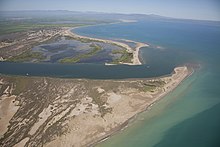

A river mouth is where a river flows into a larger body of water, such as another river, a lake/reservoir, a bay/gulf, a sea, or an ocean.[1] At the river mouth, sediments are often deposited due to the slowing of the current, reducing the carrying capacity of the water.[1] The water from a river can enter the receiving body in a variety of different ways.[1] The motion of a river is influenced by the relative density of the river compared to the receiving water, the rotation of the Earth, and any ambient motion in the receiving water, such as tides or seiches.[2]
If the river water has a higher density than the surface of the receiving water, the river water will plunge below the surface. The river water will then either form an underflow or an interflow within the lake. However, if the river water is lighter than the receiving water, as is typically the case when fresh river water flows into the sea, the river water will float along the surface of the receiving water as an overflow.
Alongside these advective transports, inflowing water will also diffuse.[1]
- ^ a b c d Charles, Hogg (2014-06-12). The flow of rivers into lakes: Experiments and models (Thesis). University of Cambridge. doi:10.17863/cam.32.
- ^ Ma, Yanxia (2009). Continental Shelf Sediment Transport and Depositional Processes on an Energetic, Active Margin: the Waiapu River Shelf, New Zealand. pp. 2, 19.